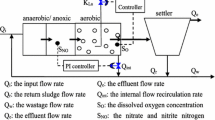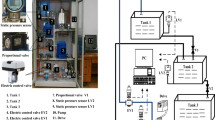Abstract
Agitator tanks are widely used in industrial fields. Improvement in their efficiency is critical to achieving high productivity. That is to say, an agitator tank system should have a short response time to produce a desired reagent with an accurate solution concentration and a moderate liquid level. Therefore, a noise-rejection zeroing dynamics (NRZD) model for the control of the agitator tank based on a neural-dynamics method with anti-noise performance is proposed in this paper. The solution concentration and the liquid level of the agitator tank synthesized by the NRZD model are able to converge to the desired trajectories polluted with different noises. Then, theoretical analyses on the convergence and anti-noise performance of the agitator tank system equipped with the NRZD model are presented. Furthermore, to verify the superiority of the agitator tank system equipped with the NRZD model, we perform tracking trajectories simulations on solution concentration and the liquid level of the agitator tank with different noises. Moreover, the simulation results verify that the NRZD model is more effective than the existing models in the reagent preparation process.











Similar content being viewed by others
References
Hu, Y., Li, C., Wang, X., Yang, Y., Zhu, H.: 1,3,4-Thiadiazole: synthesis, reactions, and applications in medicinal, agricultural, and materials chemistry. Chem. Rev. 114(10), 5572–5610 (2014)
Singh, J., Kaur, L., McCarthy, O.: Factors influencing the physico-chemical, morphological, thermal and rheological properties of some chemically modified starches for food applications-a review. Food Hydrocoll. 21(1), 1–22 (2017)
Alves, N., Mano, J.: Chitosan derivatives obtained by chemical modifications for biomedical and environmental applications. Int. J. Biol Macromol. 43(5), 401–414 (2008)
Pearse, M.: An overview of the use of chemical reagents in mineral processing. Miner. Eng. 18(2), 139–149 (2005)
Fang, J., Ling, X., Sang, Z.: Experimental and numerical studies of the flow field in a stirred tank equipped with multiple side-entering agitators. Chem. Eng. Technol. 34(10), 1619–1629 (2011)
Martin, M., Montes, F., Galán, M.: Bubbling process in stirred tank reactors I: Agitator effect on bubble size, formation and rising. Chem. Eng. Sci. 63(12), 3212–3222 (2008)
Xie, M., Zhou, G., Meng, S., Wang, B., Du, S.: Numerical simulation of flow property in polymer dissolution tank with inner-outer agitators. Chem. Eng. Sci. 40(10), 50–54 (2012)
Nienow, A.: Stirring and stirred-tank reactors. Chem. Ing. Tech. 86(12), 2063–2074 (2015)
Wei, L., Jin, L., Yang, C., Chen, K., Li, W.: New noise-tolerant neural algorithms for future dynamic nonlinear optimization with estimation on hessian matrix inversion. IEEE Trans. Syst. Man Cybern. Syst. (2019). https://doi.org/10.1109/TSMC.2019.2916892
Xie, Z., Jin, L., Du, X., Xiao, X., Li, H., Li, S.: On generalized RMP scheme for redundant robot manipulators aided with dynamic neural networks and nonconvex bound constraints. IEEE Trans. Ind. Inf. 15(9), 5172–5181 (2019)
Jin, L., Xie, Z., Liu, M., Chen, K., Li, C., Yang, C.: Novel joint-drift-free scheme at acceleration level for robotic redundancy resolution with tracking error theoretically eliminated. IEEE/ASME Trans. Mech. (2020). https://doi.org/10.1109/TMECH.2020.3001624
Duan, K., Fong, S., Chen, C.P.: Multilayer neural networks-based control of underwater vehicles with uncertain dynamics and disturbances. Nonlinear Dyn. 100(9), 3555–3573 (2020)
Wu, L.B., Park, J.H., Xie, X.P., Ren, Y.W., Yang, Z.: Distributed adaptive neural network consensus for a class of uncertain nonaffine nonlinear multi-agent systems. Nonlinear Dyn. 100(2), 1243–1255 (2020)
Luo, X., Zhou, M., Li, S., You, Z., Xia, Y., Zhu, Q.: A non-negative latent factor model for large-scale sparse matrices in recommender systems via alternating direction method. IEEE Trans. Syst. Man Cybern. Syst. 27(3), 579–592 (2015)
Luo, X., Zhou, M., Xia, Y., Zhu, Q., Ammari, A.C., Alabdulwahab, A.: Generating highly accurate predictions for missing QoS-data via aggregating non-negative latent factor models. IEEE Trans. Syst. Man Cybern. Syst. 27(3), 524–537 (2016)
Luo, X., Zhou, M., Li, S., Xia, Y., You, Z., Zhu, Q., Leung, H.: Incorporation of efficient second-order solvers into latent factor models for accurate prediction of missing QoS data. IEEE Trans. Cybern. 48(4), 1216–1228 (2018)
Xie, Z., Jin, L., Luo, X., Li, S., Xiao, X.: A data-driven cyclic-motion generation scheme for kinematic control of redundant manipulators. IEEE Trans. Control Syst. Technol. (2019). https://doi.org/10.1109/TCST.2019.2963017
Liu, H., Chen, G.: Robust trajectory tracking control of marine surface vessels with uncertain disturbances and input saturations. Nonlinear Dyn. (2020). https://doi.org/10.1007/s11071-020-05701-8
Jin, L., Yan, J., Du, X., Xiao, X., Fu, D.: RNN for solving time-variant generalized sylvester equation with applications to robots and acoustic source localization. IEEE Trans. Ind. Inf. 16(10), 6359–6369 (2020)
Mallik, W., Santra, S.: Mitigation of vortex-induced vibration lock-in using time-delay closed-loop control. Nonlinear Dyn. 100(1), 1441–1456 (2020)
Xie, R., Gong, J., Wang, X.: A new probabilistic robust control approach for system with uncertain parameters. Asian J. Control 17(4), 1330–1341 (2015)
Pradhan, S.K., Subudhi, B.: Position control of a flexible manipulator using a new nonlinear self-tuning PID controller. IEEE/CAA J. Autom. Sin. 7(1), 136–149 (2020)
Yu, X., Ding, P., Yang, F., Zou, C., Ou, L.: Stabilization parametric region of distributed PID controllers for general first-order multi-agent systems with time delay. IEEE/CAA J. Autom. Sin. (2019). https://doi.org/10.1109/JAS.2019.1911627
Khan, M.U., Kara, T.: Adaptive type-2 neural fuzzy sliding mode control of a class of nonlinear systems. Nonlinear Dyn. 101(4), 2283–2297 (2020)
Xiao, L.: Design and analysis of robust nonlinear neural dynamics for solving dynamic nonlinear equation within finite time. Nonlinear Dyn. 96(4), 2437–2447 (2019)
Wang, R., Kalnay, E., Balachandran, B.: Neural machine-based forecasting of chaotic dynamics. Nonlinear Dyn. 98(1), 2903–2917 (2019)
Xie, Z., Jin, L., Luo, X., Sun, Z., Liu, M.: RNN for repetitive motion generation of redundant robot manipulators: an orthogonal projection-based scheme. IEEE Trans. Neural Netw. Learn. Syst. (2020). https://doi.org/10.1109/TNNLS.2020.3028304
Jha, S.K., Bhasin, S.: Adaptive linear quadratic regulator for continuous-time systems with uncertain dynamics. IEEE/CAA J. Autom. Sin. 7(3), 833–841 (2020)
Yang, X., Zhao, B.: Optimal neuro-control strategy for nonlinear systems with asymmetric input constraints. IEEE/CAA J. Autom. Sin. 7(2), 575–583 (2020)
Qi, Y., Jin, L., Li, H., Li, Y., Liu, M.: Discrete computational neural dynamics models for solving time-dependent sylvester equations with applications to robotics and MIMO systems. IEEE Trans. Ind. Inf. 16(10), 6231–6241 (2020)
Zhang, J., Jin, L., Cheng, L.: RNN for perturbed manipulability optimization of manipulators based on a distributed scheme: a game-theoretic perspective. IEEE Trans. Neural Netw. Learn. Syst. (2020). https://doi.org/10.1109/TNNLS.2020.2963998
Ding, Z.: Consensus disturbance rejection with disturbance observers. IEEE Trans. Ind. Electron. 62(9), 5829–5837 (2015)
Zhang, Y., Ding, Y., Qiu, B., Wen, J., Li, X.: ZD method based nonlinear and robust control of agitator tank. Asian J. Control 20(4), 1464–1479 (2018)
Zhang, Z., Zheng, L., Qiu, T., Deng, F.: Varying-parameter convergent-differential neural solution to time-varying overdetermined system of linear equations. IEEE Trans. Autom. Control 65(2), 874–881 (2020)
Qi, Y., Jin, L., Wang, Y., Xiao, Lin, Zhang, J.: Complex-valued discrete-time neural dynamics for perturbed time-dependent complex quadratic programming with applications. IEEE Trans. Neural Netw Learn Syst. 31(9), 3555–3569 (2020)
Guo, D., Li, S., Stanimirovic, P.S.: Analysis and application of modified ZNN design with robustness against harmonic noise. IEEE Trans. Ind. Inf. 16(7), 4627–4638 (2019)
Jin, L., Li, S., Hu, B., Liu, M., Yu, J.: Noise-suppressing neural algorithm for solving time-varying system of linear equations: A control-based approach. IEEE Trans. Ind. Inf. 15(1), 236–246 (2018)
Jin, L., Zhang, Y., Li, S., Zhang, Y.: Noise-tolerant ZNN models for solving time-varying zero-finding problems: a control-theoretic approach. IEEE Trans. Autom. 62(2), 992–997 (2017)
Funding
This study was funded by the National Key Research and Development Program of China under Grant 2017YFE0118900, by the research project of Huawei Mindspore Academic Award Fund of Chinese Association of Artificial Intelligence CAAIXSJLJJ-2020-009A, by the Team Project of Natural Science Foundation of Qinghai Province, China (No. 2020-ZJ-903), by the Key Laboratory of IoT of Qinghai (No. 2020-ZJ-Y16), by the Natural Science Foundation of Gansu Province, China, under Grant 20JR10RA639, by the Natural Science Foundation of Chongqing (China) under Grant cstc2020jcyj-zdxmX0028, by the Research and Development Foundation of Nanchong (China) under Grant 20YFZJ0018, by CAS “Light of West China” Program, and by the Project Supported by Chongqing Key Laboratory of Mobile Communications Technology under Grant cqupt-mct-202004.
Author information
Authors and Affiliations
Corresponding author
Ethics declarations
Conflict of interest
The authors declare that we have no conflict of interest.
Additional information
Publisher's Note
Springer Nature remains neutral with regard to jurisdictional claims in published maps and institutional affiliations.
Rights and permissions
About this article
Cite this article
Liu, M., Li, J., Liufu, Y. et al. Noise-rejection zeroing dynamics for control of industrial agitator tank. Nonlinear Dyn 103, 2581–2603 (2021). https://doi.org/10.1007/s11071-021-06233-5
Received:
Accepted:
Published:
Issue Date:
DOI: https://doi.org/10.1007/s11071-021-06233-5




